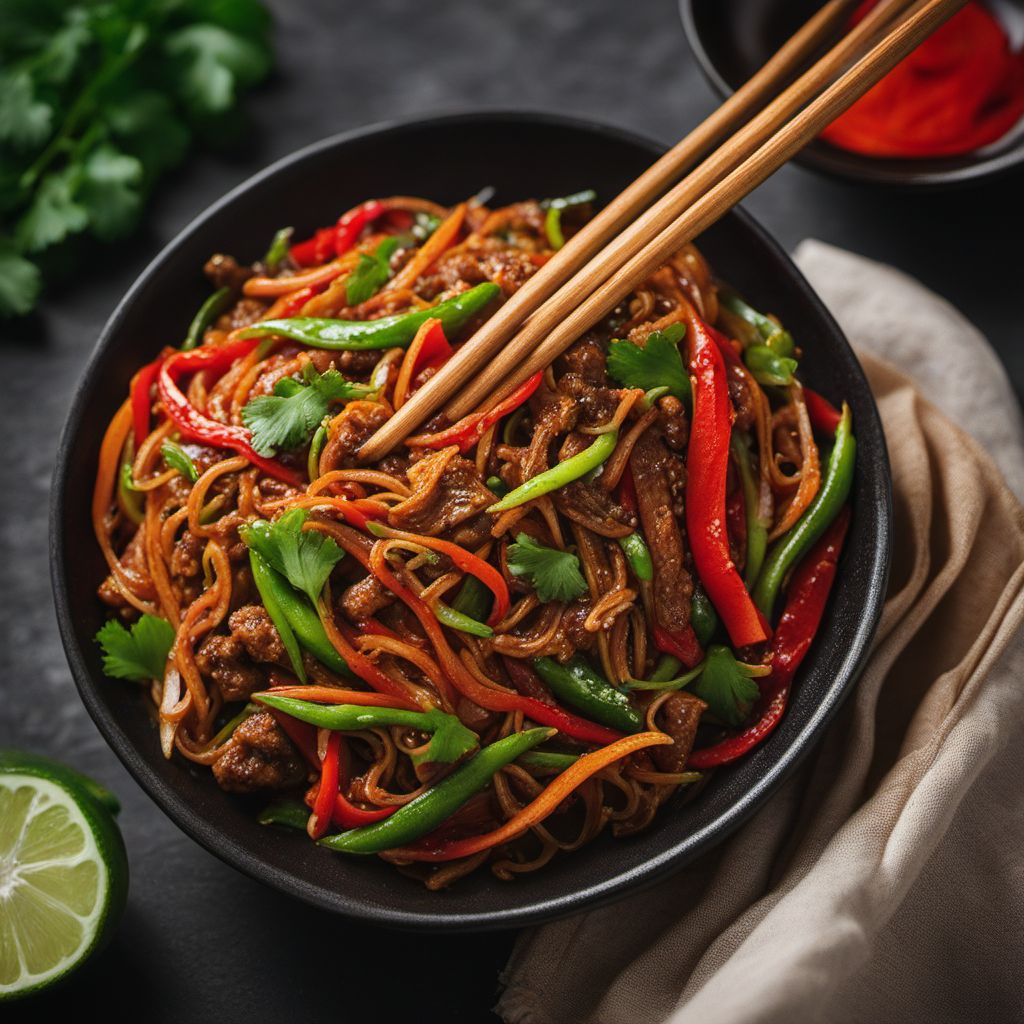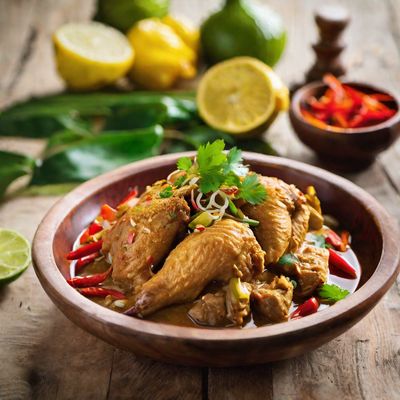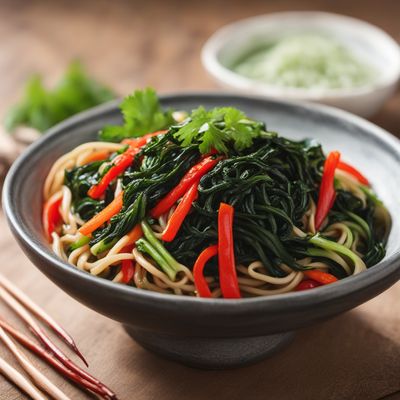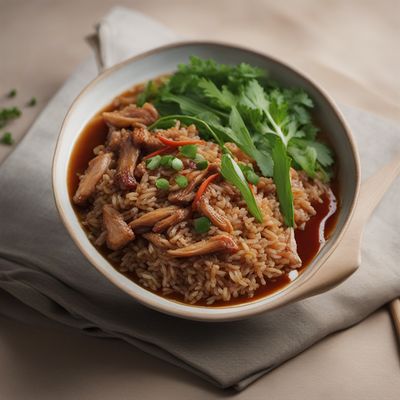
Recipe
Xinjiang Spicy Noodle Stir-Fry
Fiery Xinjiang Noodles: A Spicy Delight from the Silk Road
4.8 out of 5
Indulge in the vibrant flavors of Xinjiang cuisine with this tantalizing recipe for Xinjiang Spicy Noodle Stir-Fry. Inspired by the traditional Thai dish Pad Kee Mao, this Xinjiang adaptation combines bold spices, hearty noodles, and fresh vegetables to create a fiery and satisfying meal.
Metadata
Preparation time
20 minutes
Cooking time
15 minutes
Total time
35 minutes
Yields
4 servings
Preparation difficulty
Medium
Suitable for
Omnivore, Low carb, High protein, Dairy-free, Gluten-free (if using gluten-free soy sauce)
Allergens
Soy (in soy sauce), Oyster sauce (contains shellfish)
Not suitable for
Vegetarian, Vegan, Pescatarian, Paleo, Keto
Ingredients
This Xinjiang adaptation of Pad Kee Mao incorporates the unique flavors and spices of Xinjiang cuisine. While the original Thai dish typically uses Thai basil and fish sauce, this Xinjiang version replaces them with Xinjiang spices like cumin and Sichuan peppercorns. The choice of meat is also different, with lamb or beef being preferred in Xinjiang cuisine instead of the traditional chicken or shrimp. Additionally, the vegetables used in this adaptation are more commonly found in Xinjiang cuisine, such as bell peppers, onions, and carrots. We alse have the original recipe for Pad kee mao, so you can check it out.
-
250g (8.8 oz) wide noodles 250g (8.8 oz) wide noodles
-
300g (10.6 oz) lamb or beef, thinly sliced 300g (10.6 oz) lamb or beef, thinly sliced
-
1 red bell pepper, thinly sliced 1 red bell pepper, thinly sliced
-
1 green bell pepper, thinly sliced 1 green bell pepper, thinly sliced
-
1 onion, thinly sliced 1 onion, thinly sliced
-
2 carrots, julienned 2 carrots, julienned
-
3 cloves of garlic, minced 3 cloves of garlic, minced
-
2 tablespoons vegetable oil 2 tablespoons vegetable oil
-
1 teaspoon cumin powder 1 teaspoon cumin powder
-
1 teaspoon chili flakes 1 teaspoon chili flakes
-
1 teaspoon Sichuan peppercorns, crushed 1 teaspoon Sichuan peppercorns, crushed
-
2 tablespoons soy sauce 2 tablespoons soy sauce
-
1 tablespoon dark soy sauce 1 tablespoon dark soy sauce
-
1 tablespoon oyster sauce 1 tablespoon oyster sauce
-
Salt, to taste Salt, to taste
-
Fresh cilantro, for garnish Fresh cilantro, for garnish
Nutrition
- Calories (kcal / KJ): 420 kcal / 1760 KJ
- Fat (total, saturated): 18g, 5g
- Carbohydrates (total, sugars): 35g, 6g
- Protein: 30g
- Fiber: 5g
- Salt: 2.5g
Preparation
-
1.Cook the wide noodles according to package instructions. Drain and set aside.
-
2.Heat the vegetable oil in a wok or large skillet over high heat.
-
3.Add the minced garlic and stir-fry for a few seconds until fragrant.
-
4.Add the sliced lamb or beef and cook until browned and cooked through.
-
5.Add the sliced bell peppers, onion, and julienned carrots. Stir-fry for 2-3 minutes until the vegetables are slightly tender.
-
6.In a small bowl, mix together the cumin powder, chili flakes, crushed Sichuan peppercorns, soy sauce, dark soy sauce, and oyster sauce.
-
7.Pour the sauce mixture over the stir-fry and toss to coat the ingredients evenly.
-
8.Add the cooked noodles to the wok and stir-fry for an additional 2-3 minutes, allowing the flavors to meld together.
-
9.Season with salt to taste.
-
10.Garnish with fresh cilantro and serve hot.
Treat your ingredients with care...
- Lamb or beef — For tender meat, slice it against the grain. Marinating the meat with a little soy sauce and cornstarch for 15 minutes before cooking can enhance its tenderness.
- Cumin powder — Toasting whole cumin seeds and grinding them fresh will elevate the flavor of the dish.
- Sichuan peppercorns — Toast the peppercorns in a dry pan before crushing them to release their aromatic oils.
Tips & Tricks
- For an extra kick of heat, add a few dried red chili peppers to the stir-fry.
- Customize the vegetable selection based on personal preference or seasonal availability.
- Adjust the amount of chili flakes and Sichuan peppercorns according to your spice tolerance.
- For a vegetarian version, replace the meat with tofu or seitan.
- Serve the Xinjiang Spicy Noodle Stir-Fry with a side of vinegar-pickled vegetables to balance the heat.
Serving advice
Serve the Xinjiang Spicy Noodle Stir-Fry hot, garnished with fresh cilantro. It pairs well with a squeeze of lime juice for a tangy twist. Enjoy it as a standalone meal or with a side of steamed rice for a heartier option.
Presentation advice
Present the Xinjiang Spicy Noodle Stir-Fry in a vibrant and colorful manner. Arrange the stir-fried noodles and vegetables on a large serving platter, allowing the colors to pop. Garnish with fresh cilantro for a touch of greenery.
More recipes...
For Pad kee mao
For Thai cuisine » Browse all
More Thai cuisine dishes » Browse all

Miang kham
Miang kham is a traditional Thai snack that consists of various ingredients wrapped in a betel leaf.

Pa thong ko
Pa thong ko is a traditional Thai snack made from rice flour and yeast, deep-fried and served with a sweet chili sauce.

Kluai thot
Fried banana
Kluai thot is a traditional Thai dessert that is made from bananas and coconut milk. It is often served during festivals and special occasions.









